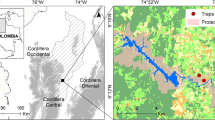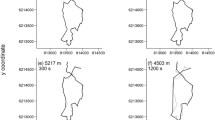Abstract
There are few data on the daily ranging distances of Yunnan snub-nosed monkeys (Rhinopithecus bieti). We fitted 1 adult male from a natural group at Jinsichang in China’s Yunnan Province with a global positioning system (GPS) collar and tracked him from December 2003 to October 2004 to estimate the daily ranging distances of the group. The total acquisition rate of the GPS collar was 82.2%, which indicates that one can use GPS collars to track the species efficiently in high-altitude, temperate, coniferous forest. We obtained group locations or fixes at 5 predetermined times during the day. The sleeping sites of the subjects are the key points to estimate the day range. We compared 2 measures of day range: the 2-point straight-line displacement and the multipoint cumulative daily ranging distance. Straight-line displacement between 2 consecutive mornings or 2 consecutive evenings can substitute for that between the morning sleeping site and the evening sleeping site. In general, the group does not move at night. The 2 measures of day range yielded different results. The multipoint cumulative daily ranging distance was the method of choice to measure their daily travel costs. The minimum required number of fixes per day was 3. Per statistical evidence, the number of full-day group follows per month influences the estimate of day range of the group and ≥10 d is required to obtain a reliable estimate; 5 d per month might not be enough. We dealt mainly with the methodologic aspects of day range calculations. We did not address functional aspects on the estimate of day range, viz. the influence of vegetation, food distribution patterns, climate change, seasonality, and the monkey group itself.

Similar content being viewed by others
References
Altmann, S. A., & Altmann, J. (1970). Baboon Ecology: African Field Research. Chicago, IL: University of Chicago Press.
Bai, S. C., Zou, S. Q., Lin, S., Tuo, D., Zhong, T., & Wang, X. H. (1988). An investigation of distribution, number and food habit of Rhinopithecus bieti. Zoological Research, 9(Suppl.), 67–75.
Bennett, E. L. (1986). Environmental correlates of ranging behaviour in the banded langur, Presbytis melalophos. Folia Primatologica, 47, 26–38.
Chen, F. G., Min, Z. L., Luo, S. Y., & Xie, W. Z. (1983). An observation on the behavior and some ecological habits of the golden monkey (Rhinopithecus roxellana) in Qinling Mountains. Acta Theriologica Sinica, 3, 141–146.
Defler, T. R. (1996). Aspects of the ranging pattern in a group of wild wooly monkeys (Lagothrix lagothricha). American Journal of Primatology, 38, 289–302.
DeVore, I., & Hall, K. R. L. (1965). Baboon ecology. In I. DeVore (Ed.) Primate behavior: Field studies of monkeys and apes (pp. 20–52). Boston: Harvard University Press.
Ding, W., & Zhao, Q. K. (2004). Rhinopithecus bieti at Tacheng, Yunnan: Diet and daytime activities. International Journal of Primatology, 25, 583–589.
Fossey, D., & Harcourt, A. H. (1977). Feeding ecology of free-ranging mountain gorilla (Gorilla gorilla beringei).. In T. H. Clutton-Brock (Ed.) Primate ecology: Studies of feeding and ranging behaviour in Lemurs, Monkeys and Apes (pp. 415–447). London: Academic Press.
Gautier-Hion, A., Gautier, J. P., & Quris, R. (1981). Forest structure and fruit availability as complementary factors influencing habitat use by a troop of monkeys (Cercophithecus cephus). Revue D Ecologie, 35, 511–536.
Goodall, A. G. (1977). Feeding and ranging behaviour of a mountain gorilla group (Gorilla gorilla beringei) in the Tshibinda-Kahuzi region (Zaїre). In T. H. Clutton-Brock (Ed.) Primate Ecology: Studies of Feeding and Ranging Behaviour in Lemurs, Monkeys and Apes (pp. 449–479). London: Academic Press.
Harrison, M. J. S. (1983). Patterns of range use by the green monkey, Cercopithecus sabaeus, at Mt. Assirik, Senegal. Folia Primatologica, 41, 157–179.
Hooge, P. N., & Eichenlaub, B. (1997). Animal movement extension to Arcview. Ver. 1.1., Alaska Science Center—Biological Science Office. Anchorage, AK: U.S. Geological Survey.
Hu, J. C., Deng, Q. X., Yu, Z. W., Zhou, S. D., & Tian, Z. X. (1980). Ecological and biological research of the giant panda and golden-haired monkey. Journal of Nanchong Teacher’s College, 2, 1–29.
Isbell, L. A. (1983). Daily ranging behavior of red colobus (Colobus badius tephrosceles) in Kible forest, Uganda. Folia Primatologica, 41, 34–48.
Isbell, L. A., Pruetz, J. D., Nzuma, B. M., & Young, T. P. (1999). Comparing measures of travel distances in primates: Methodological considerations and socioecological implications. American Journal of Primatology, 48, 87–98.
Johnson, A., Singh, S., Doungdala, M., Chanthasone, B., Namsombath, T., & Hedemark, M. (2003). A preliminary survey for gibbon and other primates in the Nam Ha National Protected Areas, Lao PDR, February 2004. Vientiane, Laos: Wildlife Conservation Society.
Jolly, A. (1985). Evolution of primate behavior pp. 87–114. New York: Macmillan Publishing Company.
Kirkpatrick, R. C. (1996). Ecology and behavior of the Yunnan snub-nosed langur (Rhinopithecus bieti, Colobinae). Dissertation, University of California, Davis, pp. 39–67.
Koenig, A., Borries, C., Chalise, M. K., & Winkler, P. (1997). Ecology, nutrition, and timing of reproductive events in an Asian primate: Hanuman langur (Prestybis entellus). Journal of Zoology, London, 243, 215–235.
Li, B. G., Chen, C., Ji, W. H., & Ren, B. P. (2000). Seasonal home range changes of the Sichuan snub-nosed monkey (Rhinopithecus roxellana) in the Qinling Mountains of China. Folia Primatologica, 71, 375–386.
Li, Y. M. (2002). The seasonal daily travel in a group of Sichuan snub-nosed monkey (Pygathrix roxellana) in Shennongjia Nature Reserve, China. Primates, 43, 271–276.
Liu, S. F. (1959). A preliminary investigation of the golden monkey in Qinling Mountains (in Chinese with English abstract). Journal of Northwest University, 3, 19–26.
Liu, Z. H., Ding, W., & Grüter, C. C. (2004). Seasonal variation in ranging patterns of Yunnan snub-nosed monkeys Rhinopithecus bieti at Mt. Fuhe, China. Acta Zoologica Sinica, 50, 691–696.
Long, Y. C., Kirkpatrick, C. A., Xiao, L., & Zhong, T. (1998). Time budgets of the Yunnan snub-nosed monkey (Rhinopithecus (Rhinopithecus) bieti). In N. G. Jablonski (Ed.) The natural history of the Doucs and Snub-nosed Monkeys (pp. 279–289). Singapore: World Scientific Publishing.
Long, Y. C., Kirkpatrick, C. R., Zhong, T., & Xiao, L. (1996). Status and conservation strategy of the Yunnan snub-nosed monkey (in Chinese). Chinese Biodiversity, 4, 145–152.
McKey, D. B., & Waterman, P. G. (1982). Ranging behaviour of a group of black colobus (Colobus satanus) in the Douala-Edea Reserve, Cameroon. Folia Primatologica, 36, 76–98.
Muoria, P. K., Karere, G. M., Moinde, N. N., & Suleman, M. A. (2003). Primate census and habitat evaluation in the Tana delta region, Kenya. African Journal of Ecology, 41, 157–163.
Olupot, W., Chapman, C. A., Brown, C. H., & Waser, P. M. (1994). Mangabey (Cercocebus albigena) population density, group size, and ranging: A twenty-year comparison. American Journal of Primatology, 32, 197–205.
Phillips, K. A., Elvey, C., & Abercrombie, C. L. (1998). Applying GPS to the study of primate ecology: A useful tool? American Journal of Primotology, 46, 167–172.
Rempel, R. S., Rodgers, A. R., & Abraham, K. F. (1995). Performance of a GPS animal location system under boreal forest canopy. Journal of Wildlife Management, 59, 543–551.
Shi, D. C., Li, G. H., & Hu, T. Q. (1982). Preliminary studies on the ecology of the golden-haired monkey. Zoological Research, 3, 105–110.
Shimooka, Y. (2005). Sexual differences in ranging of Atelis belzebuth belzebuth at La Macarena, Colombia. International Journal of Primatolology, 26, 385–406.
Sigg, H., & Stolba, A. (1981). Home range and daily march in a Hamadryas baboon troop. Folia Primatologica, 36, 40–75.
Sprague, D. S., Kabaya, H., & Hagihara, K. (2004). Field testing a global system (GPS) collar on a Japanese monkey: Reliability of automatic GPS positioning in a Japanese forest. Primates, 45, 151–154.
Steudel, K. (2000). The physiology and energetics of movement: Effects on individuals and groups. In S. Boinski, & P. A. Garber (Eds.) On the move: How and why animals travel in groups (pp. 11–23). Chicago: University of Chicago Press.
Stevenson, P. R., Quinones, M. J., & Ahumada, J. A. (1994). Ecological strategies of woolly monkeys (Lagothrix lagotricha) at Tinigua National Park, Colombia. American Journal of Primatology, 32, 123–140.
Su, Y. J., Ren, R. M., Yan, K. H., Li, J. J., Zhou, Y., Zhu, Z. Q., et al. (1998). Preliminary survey of the home range and ranging behavior of golden monkeys (Rhinopithecus (Rhinopithecus) roxellana) in Shennongjia Natural Reserve, Hubei, China. In N. G. Jablonski (Ed.) The natural history of the Doucs and Snub-nosed Monkeys (pp. 255–268). Singapore: World Scientific Publishing.
Tarnaud, L. (2006). Cathemerality in the Mayotte Brown lemur (Eulemur fulvus): Seasonality and food quality. Folia Primatologica, 77, 166–177.
White, G. G., & Garrott, R. A. (1990). Analysis of wildlife radio-tracking data. San Diego: Academic Press.
Wu, B. Q. (1991). Survey and analysis of feeding habits of Rhinopithecus bieti (in Chinese). Acta Anthropologica Sinica, 10, 357–371.
Xiang, Z. F. (2005). The Ecology and Behavior of Black-and-White Snub-nosed Monkeys (Rhinopithecus bieti, Colobinae) at Xiaochangdu in Honglaxueshan National Nature Reserve, Tibet, China (dissertation). Kunming, China: Kunming Institute of Zoology, Chinese Academy of Sciences, pp.83–98.
Xiao, W., Ding, W., Cui, L. W., Zhou, R. L., & Zhao, Q. K. (2003). Habitat degradation of Rhinopithecus bieti in Yunnan, China. International Journal of Primtatology, 24, 389–398.
Yamagiwa, J., & Mwanza, N. (1994). Day-journey length and daily diet of solitary male gorillas in lowland and highland habitats. International Journal of Primatology, 15, 207–224.
Yang, S. J. (2000). Habitat, diet, range use and Social Organization of Rhinopithecus bieti at Jinsichang (dissertation in Chinese). Kunming, China: Kunming Institute of Zoology, Chinese Academy of Sciences.
Yang, Y. Q., Lei, X. P., & Yang, C. D. (2002). Ecology of the wild Guizhou Snub-nosed Monkey pp. 1–5. Guiyang: Guizhou Science and Technique Publishing House.
Acknowledgments
A grant from TNC China Program and funding from the National Natural Science Foundation of China (No. 30470310) and the Key Project of Natural Science Foundation of China (No. 30630016) supported our research. We thank our field assistants, Z. M. Zhang, Y. J. Zhang, and X. R. Yang, and R. D. Wu for the integration of many data sets into the ArcView system. We also appreciate R. D. Wu’s help in calculating some basic parameters for our final analysis. The State Forestry Administration of China and the Forestry Bureau of Yulong County also supported the field work. We acknowledge the 2 anonymous reviewers and Daniel White for valuable comments and language editing.
Author information
Authors and Affiliations
Corresponding author
Rights and permissions
About this article
Cite this article
Ren, B., Li, M., Long, Y. et al. Measuring Daily Ranging Distances of Rhinopithecus bieti via a Global Positioning System Collar at Jinsichang, China: A Methodological Consideration. Int J Primatol 29, 783–794 (2008). https://doi.org/10.1007/s10764-008-9251-z
Received:
Accepted:
Published:
Issue Date:
DOI: https://doi.org/10.1007/s10764-008-9251-z




